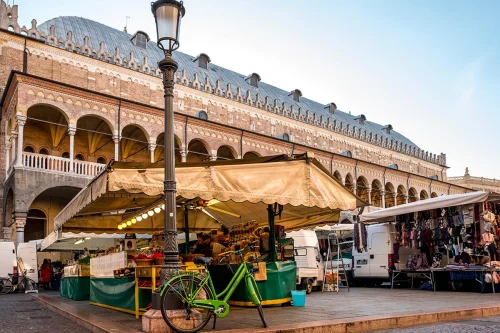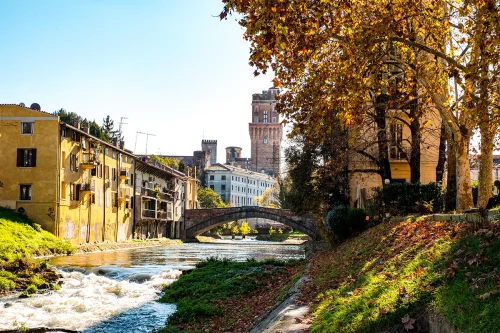
The 10 things not to miss in Padua

The way to Venice
Like the ancient Venetian nobles, you can retrace the historic canals that led from Padua to Venice, along the Riviera del Brenta following the route of its historic villas, crossing the lagoon until you arrive in St. Mark's Square.

Scrovegni Chapel (by GIOTTO)
The Scrovegni Chapel contains one of the greatest masterpieces of 14th-century Italian and European painting, the most complete cycle of frescoes created by the great Tuscan master in his maturity. Please note that the visit can only be made by reservation (by calling +39 049 2010020, or through the following link https://www.cappelladegliscrovegni.it) Opening hours are from 09.00 to 19.00; in the summer months, an evening visit will also be possible from 19.00 to 22.00.

Basilica del Santo and Prato della Valle
The religious heritage of the City of Padua is extraordinarily rich. To visit the main places of faith, one can start from the Basilica of St. Anthony, better known as the Basilica del Santo, a majestic and complex religious building begun in 1232. The Prato della Valle is the largest square in the city and among the largest in Italy and Europe. The current configuration dates back to the late 18th century and is characterized by a central elliptical island, called Memmia Island surrounded by a small canal on whose banks is a double ring of statues.

Palace of Reason
Palazzo della Ragione, erected in 1218 by Giovanni degli Eremitani, was the seat of the city courts until 1797. The upper floor is occupied by the largest hanging hall in the world. It is called precisely the "Salone" and is frescoed with a grand cycle of frescoes on astrological subjects. Inside is housed the largest Faucault pendulum ever made.

Subsurface
The Palazzo della Ragione, on the ground floor, houses a series of stores located on two galleries running along the main axis of the building. Here you can buy the typical products of Paduan gastronomy, selected and of excellent quality. This sort of ancient shopping mall is familiarly known among Paduans as "sotto il salone".

Pedrocchi University and Cafe
The University of Padua is one of the oldest in the world (the second in Italy after Bologna). Palazzo Bo became the seat of the University from the end of the 15th c. Of great architectural interest is the Cortile Antico, while historical excellences are the Sala dei Quaranta, where Galileo's chair is preserved, the Aula Magna, rich in coats of arms and decorations, and the world's famous and oldest stable anatomical theater (1594). On the way out you can taste, inside the elegant Caffe Pedrocchi (1831), Padua's most famous coffee, the Pedrocchino (bitter espresso with added cold mint and a dusting of cocoa).

Botanical Garden
Built in 1545 as the "Orto dei Semplici" (medicinal plants) of the Faculty of Medicine, it was arranged by arch. Andrea Moroni. It is the oldest university botanical garden in Europe and houses important collections of historical plants.

Spritz and typical dinner
What will remain most of all in the memories of the stay in this fantastic city is the spritz, the typical aperitif made with Prosecco D.o.c., which for the Paduans is undoubtedly a ritual that preludes dinner, but it is also and above all a moment of sharing and gathering, for the young, but not only...

Jewish Quarter
The beauty of one of the oldest Jewish community sites in Italy lies in its narrow streets, the striking facades of some of the small palaces, the tall dwellings, and the small stores of ancient tradition, which have spread to the surrounding streets as well.

The Dome
Dedicated to St. Mary of the Assumption, the cathedral that can be seen today was built between the 16th and 18th centuries. From the outside, particularly from Via Dietro Duomo, one can easily notice the three apses with which the nave ends, the two terminal apses of the transept, the bell tower, the dome with its high drum, and the large lantern. The harmonious and monumental interior has a Latin cross plan. Numerous and very valuable works of art are preserved in the cathedral.

Capitanio Palace
The Palazzo del Capitanio stands on the western side of Piazza dei Signori, opposite the Church of St. Clement. It is famous because the Captain, one of the two Venetian regents of the city, used to stay there. Halfway up the palace rises an ancient tower where stands an astronomical clock built in 1947. It is the first clock of its kind built in Italy: it marks the hours and minutes, but also the month, day and moon phases.

The Specola
Site of the ancient astronomical observatory of the University of Padua, the Specola is undoubtedly one of the most representative symbols of the city and its history. A respectable attraction located in the heart of the city that will captivate you if you are passionate about astronomy and surprise you if you are not. You will retrace the premises where great scientists (including Galileo) studied and stayed, and you will be able to admire the splendid view from the top of the Observatory tower.
Contact
We are here to answer all your questions and make your stay in Padua unforgettable.
Info & reservations CALL US